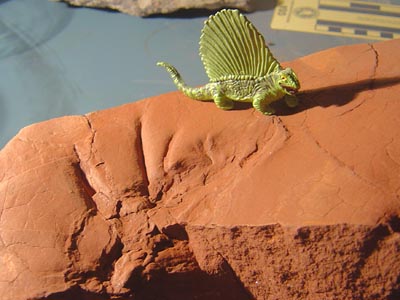 |
Fossils
from the Permian
Hermit
Shale in the
Sedona/Oak
Creek Area
|
Updated 2/25/07
 |
The middle Permian terrestrial
formations in central Arizona, the Mogollon Rim area and within
the walls of the Grand Canyon represent a massive mud flat with
many braided flu vial channels on the edge of the sea that produced
the Fort Apache Limestone and some of the marine deposits in
the Supai Group in the Grand Canyon. In the Sedona and Village
of Oak Creek area in central Arizona this group of formations
is called the Schnebly Hill formation and consists of four members.
The lower most is the Hermit Shale itself which in numerous localities
we find locally abundant plant hash, conifer material, calamities,
and sedimentary structures such as mud cracks, wave ripples and
cross bedding. Also occasionally found are reptile tracks and
track ways, the smallest are lizard sized reptiles, and the largest
are huge mammal like reptile prints from such dramatic creatures
such as the sail backed reptile - Dimetrodon. The remaining upper
layers are in order, the Bell Rock member which is shale and
sandstones, The Fort Apache Limestone which is marine, and the
cap rock on many buttes is both the Fort Apache or the upper
Schnebly Hill sandstones - the Sycamore Pass member.
On this expedition,
we were joined by our good friend from Queensland Australia,
Paul Tierney. We explored the lower slopes in the Hermit, and
here you will find a photo pictorial of our trip and some of
the fine fossils we found that day.
|
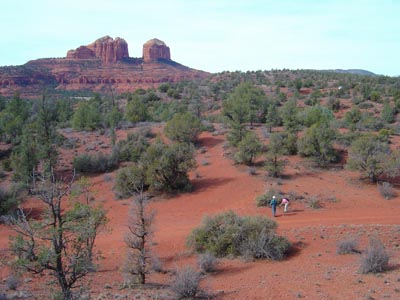 | Hiking
back on many of the trails in the area, we found abundant trace
fossils, and plant hash in many of the shale outcrops. In the
background is the back of the view from Red Rock Crossing. |
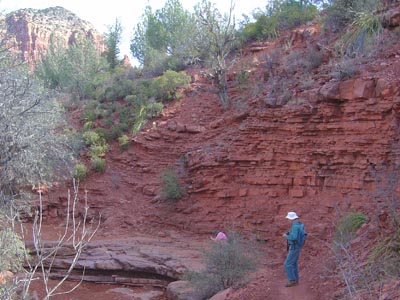 | Dawn
and Paul at one of the river cut outcrops far off the main road.
Here at this site were plenty of sedimentary structures in the
ancient Permian rock such as wave ripples, rain drop impressions
from a single event in time. There was a huge fossil log here
as well up on the cliff perhaps a huge calamities or Walchia
trunk still in life position. | 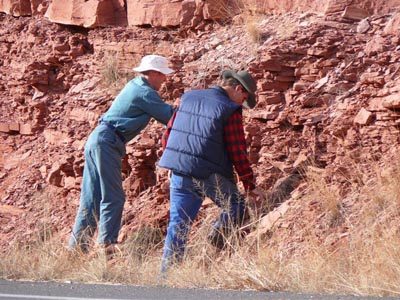 | At a road cut off the beaten
path, we found many of the shales were crossed with mud cracks
criss crossed with fossil centipede track ways, mesichnium. We
also found a huge pair of pelycosaur manus (front foot)
impressions. | 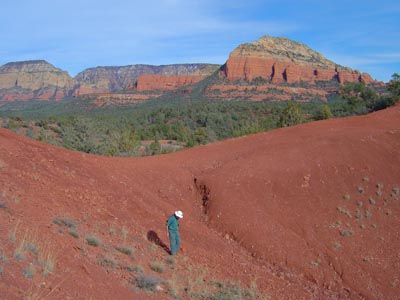 | This
is our site we call "Insect Hill", because at one time
I found some beetle track ways in the shales near the top. Now
a days, we fine mostly huge conifer fronts - Walchia, reptile
track ways, and some plant hash. Paul is here examining the eroding
shales. | 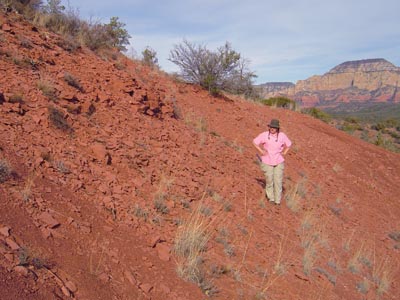 | With
so many shales to ponder, you can spend a great deal of time
on each outcrop looking through mostly blank unfossilferous material.
Then, without warning you will come across a beautiful conifer
front, or fern. Dawn is planning here assault on one such outcrop. |
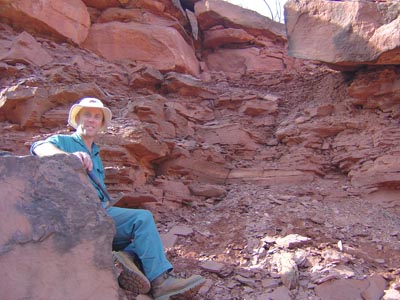 | Paul
had about as much fun climbing around on the shale beds as actually
finding the plant fossils contained within! Here we found some
very nice calamities stems, roots and branches. |
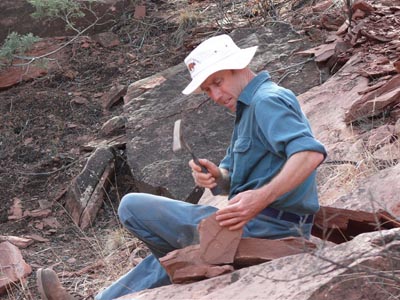 | In
many areas, splitting shales is mandatory. Many of the slabs
that are fossiliferous on the outside also contain fresh material
within. Paul shows off his cleaving skills here, and extracts
a perfect specimen! | 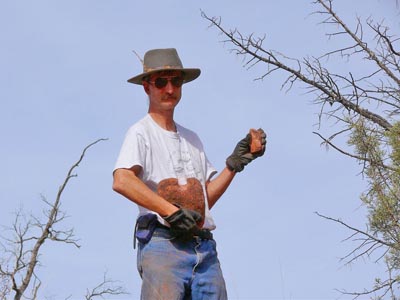 | The Author (me) after I
had just found a three inch diameter calamities trunk, and the
rock mold it came out of. | 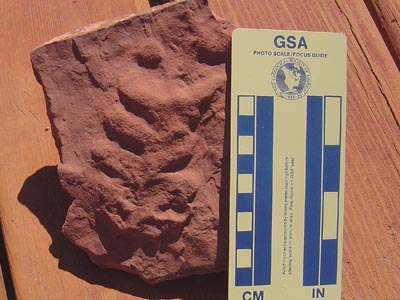 | Here are two specimens
of the fern Pecopteris, one of the most common plant fossils
we found that day. Preservation is usually not in great detail,
but large slabs of four foot frond sprays have been found by
us on earlier trips to this area. | 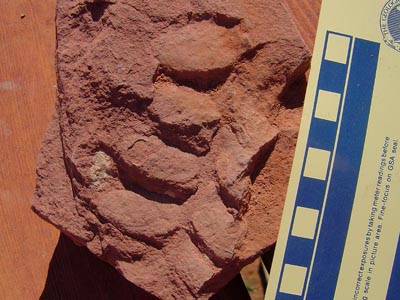 | Better preservation of
the leaves of Pecopteris, this one from a locality where we found
numerous track impressions of mammal like reptiles. |
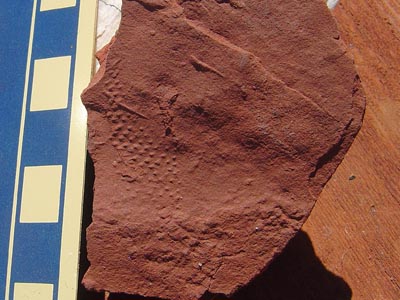 | Bark
impressions of either a Lycopod or Walchia. Small diamond shaped
patterns appear on close examination. | 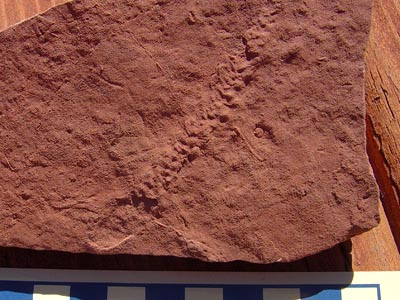 | Typically,
we find small pieces of Walchia fronds, here one twig from a
frond shows the small needles this early conifer possessed. |
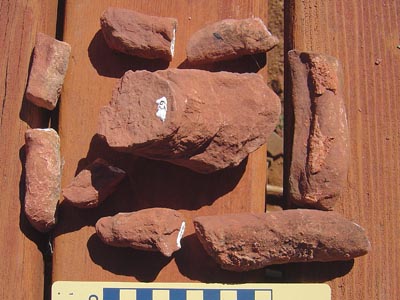 | Here
are some of the numerous stems, roots and trunks we find in the
Hermit of calamities (horse tail). Some of the trunks are up
to 10 inches or more in diameter! In the center here is a 2 inch
diameter trunk section, with the ribs visible, and around it
roots and branch like pieces. | 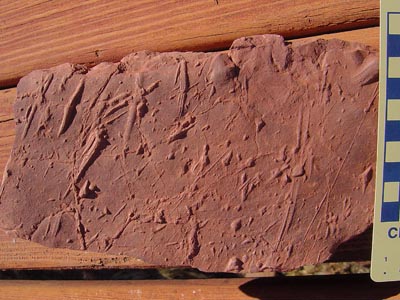 | Tooling marks are very
common in the Hermit. These can be thought of as "branch
drag marks" at the bottom of a muddy stream. While some
of the impressions in this slab are trace fossils, most are linear
and are produced by debris. | 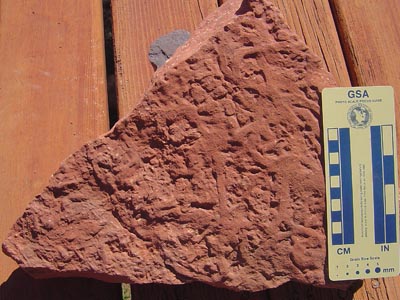 | Large slabs of worm burrows
appear also in the Hermit. This one was found very near the location
of the first picture at the top of this page, in a dry creek.
This is similar to Paleophycus, but represents a terrestrial
organism such as a feeding trace of a large worm like creature. |
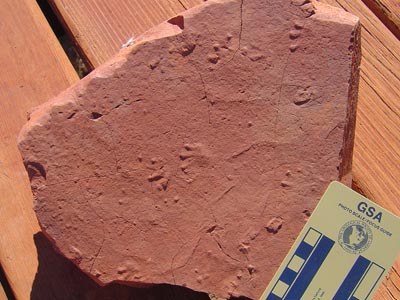 | This
slab, about 10 inches across from near Insect Hill. The footprints
of a small reptile can be seen here, which walked this mud flat
some 280 million years ago, and looks nearly as fresh as the
day it was made. The toe pads on the ends may help us identify
the family of the track maker. | 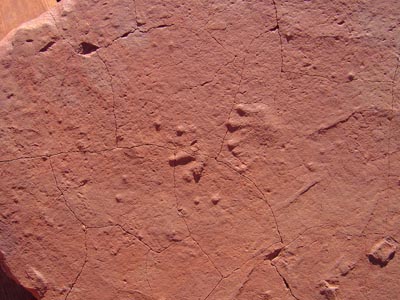 | Close up of the footprints
on the slab above showing a manus and pes impression. |
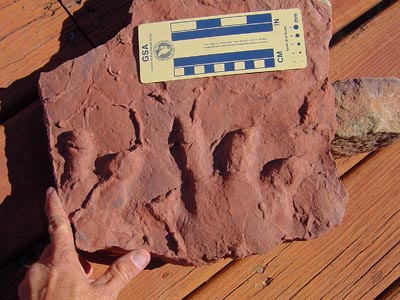 | Huge
Pelycosaur prints, both probably manus impressions. You can tell
something very significant here, that the huge animal walked
upright without its legs splayed, since the tracks are right
next to each other. One could also argue that the front feet
were splayed and rear more erect to produce a front and back
track impression. Either way, such a track pair is typical Pelycosaur,
but not Dimetrodon. | 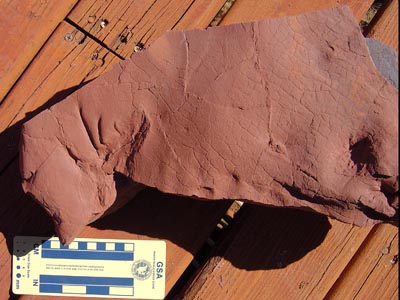 | On the left is "Dimetropodus",
the clawed track of the Dimetrodon. It is the only animal that
produces such a track. The huge front foot claws dug deeply into
the mud. This animal may have been a juvenile, the track is fairly
small. On the right is another very interesting print from another
reptile, Ill get to that in a minute. | 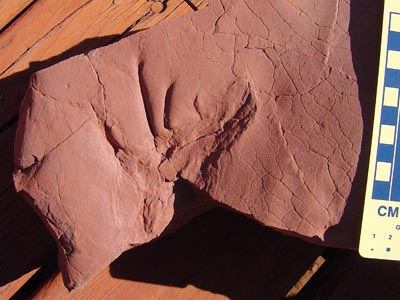 | Dimetrodon
was here. Over a quarter of a billion years ago to boot. The
amazing claw impressions are the hallmark of this reptile. |
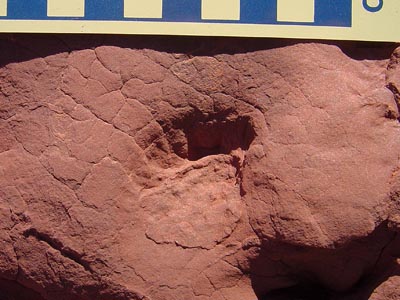 | A surprise
on the same slab was this "Laoporis like" track, similar
to what we find in the Permian Coconino sandstone, which is a
bit younger in age. This one however appears to show skin impressions
on the ball of the foot, and is a first for the many tracks we
have found in the Hermit Shale. | 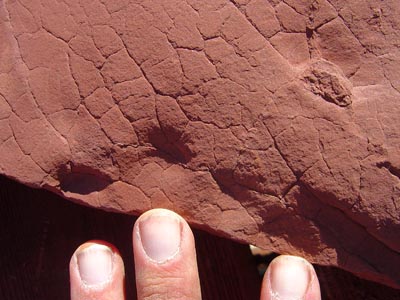 | Also on the same slab
we have the toe imprints of a mammal like reptile that we
have found from time to time in the Hermit, five large toes dig
into the mud with hints on more complete specimens of a larger
foot impression that can be over 7 inches across. |
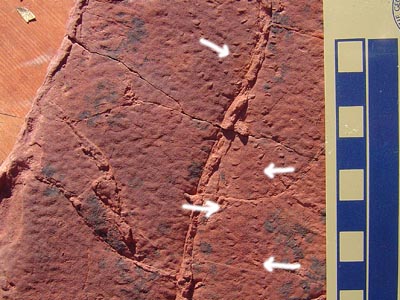 | Mesichinium
- Centipede Track ways. They look like bulldozer tracks seen
arrowed on this slab. The track maker? On a prior trip to this
same outcrop, we found a body impression of a centipede. Case
closed! |  | Finally,
we reflect for a moment of some of the amazing yet very rare
fossils we have explored in the Hermit Shale in the Sedona/Oak
Creek area and consider that we have walked on the very muddy
shores as the giant sail backed reptiles shared with the huge
tree sized horsetails and amazing short spined conifers did,
285 million years before. |
Paleo HOME

 FastCounter by bCentral
FastCounter by bCentral
|